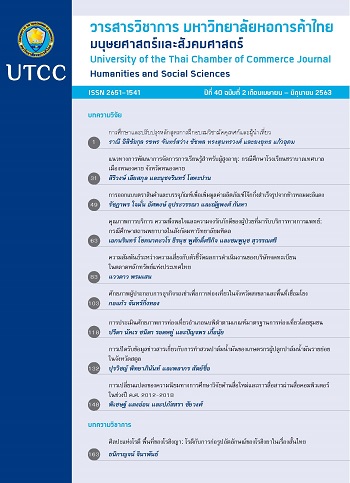The Changing of Academic Research Trends on New Media and Computer-Mediated Communication Between 2012 – 2018 CE
Main Article Content
Abstract
This research aims to study the changing of academic research trends in New Media and Computer-Mediated Communication between 2012 – 2018 CE. The scholars and researchers can use the results as the support data to design the modern future researches that conform with nowadays international academic trends. Use the qualitative research method, the abstract analysis from an academic journal in the field of new media and computer-mediated communication. 192 academic journal abstracts from the Journal of Computer-Mediated Communication (JCMC, the 1st ranking of communication journals in ISI database) are chosen. First, separate and categorize the data, study the frequency and relation between each category. Thence, synthesize and integrate the analytics data to concise the annual research trends and the changing of research trends from 2012 – 2018 CE. The results are found that the present and nearly future of academic research trends focus mainly on digitally mediated communication especially digital mobile devices. These trends also cover the researches from the developing countries, researches in political communication behaviors, new research methodology and methods such as social network analysis, data analysis system, algorithm-based of artificial intelligence, and machine learning. However, some of these trends are not the expertise of scholars or researchers in humanities and social sciences. It is necessary to seek cross-disciplinary cooperatives that needed for researches to conform to international research trends.
Article Details
ลิขสิทธิ์ของบทความ
ผลงานที่ได้รับการตีพิมพ์ถือเป็นลิขสิทธิ์ของมหาวิทยาลัยหอการค้าไทย ห้ามมิให้นำเนื้อหา ทัศนะ หรือข้อคิดเห็นใด ๆ ของผลงานไปทำซ้ำ ดัดแปลง หรือเผยแพร่ ไม่ว่าทั้งหมดหรือบางส่วนโดยไม่ได้รับอนุญาตเป็นลายลักษณ์อักษรจากมหาวิทยาลัยหอการค้าไทยก่อน
References
Daft, R. L., & Lengel, R. H. (1986). Organizational information requirements, media richness and structural design. Management Science, 32, 554-571.
Ellis, C. A., Gibbs, S. J., & Rein, G. L. (1991). Groupware: Some issues and experiences. Communication of the ACM, 34(1), 38-58.
Flew, T. (2014). New media (4th ed.). Melbourne, Australia: Oxford University Press.
Infante, D. A., Rancer, A. S., & Womack, D. F. (2003). Building communication theory (4th ed.). Prospect Heights, IL: Waveland Press.
Knapp, M. L., & Daly, J. A. (2011). The SAGE handbook of interpersonal communication (4th ed.). Thousand Oaks, CA: Sage.
Lindlof, T. R., & Taylor, B. C. (2002). Qualitative communication research methods (2nd ed.). Thousand Oaks, CA: Sage.
Ling, R. (2018). Editor’s note: JCMC in an exciting new era. Journal of Computer-Mediated Communication, 23(2), 70-71. doi:10.1093/jcmc/zmy003
Littlejohn, S. W., & Foss, K. A. (2011). Theories of human communication (10th ed.). Long Grove, IL: Waveland Press.
Perry, M. S., & Werner-Wilson, R. J. (2011). Couples and computer-mediated communication: A closer look at the affordances and use of the channel. Family & Consumer Science Research Journal, 40(2), 120-134.
Rice, R. E. (1999). Artifacts and paradoxes in new media. New Media & Society, 1(1), 24-32. doi:10.1177/1461444899001001005
Walther, J. B. (1992). Interpersonal effects in computer-mediated interaction: A relational perspective. Communication Research, 19, 52-90.
Walther, J. B. (1996). Computer-mediated communication: Impersonal, interpersonal, and hyperpersonal interaction. Communication Research, 23, 3-43.
Walther, J. B. (2011). Theories of computer-mediated communication and interpersonal relations. In M. L. Knapp and J. A. Daly (Eds.), The SAGE Handbook of Interpersonal Communication (4th ed., pp. 443-479). Thousand Oaks, CA: Sage.
Walther, J. B., & Parks, M. R. (2002). Cues filtered out, cues filtered in: Computer-mediated communication and relationships. In M. L. Knapp & J. A. Daly (Eds.), Handbook of interpersonal communication (3rd ed., pp. 529-563). Thousand Oaks, CA: Sage.


